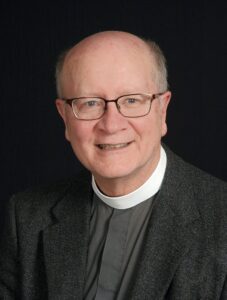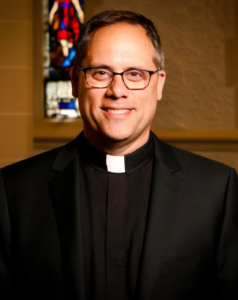History of Grace Church
Our “Genesis”
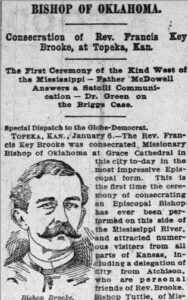
“The Rev. Francis Key Brooke was consecrated Missionary Bishop of Oklahoma at Grace Cathedral in this city to-day in the most impressive Episcopal form.” St. Louis Globe-Democrat, January 7, 1893. Shortly before his consecration, a young woman named Mary Morris had traveled by train from New York, across the Arkansas River, and into what is now Muskogee. She was accompanied by her newly-wed older brother and his bride. Mary’s physician had recommended relocating to a warmer climate and Indian Territory was just that. Newlyweds Fred and Florence Morris allowed young Mary to “tag” along on their journey into Indian Territory, which resulted in her earning the nickname “Tag.”
Tag had read about Bishop Brooke’s new post and that he would be headquartered in Guthrie. She sent a letter requesting that the new Bishop be informed about a family in Muskogee hopeful for a visit and opportunity to attend a service in their new hometown. Bishop Brooke responded with approval and notified Tag he would stop in Muskogee on his already planned journey to Tahlequah. Tag and the rest of the Morris family quickly went to work planning for the visit and were happily surprised to find three other Episcopalian families residing in town. Reverend M. L. Butler, Pastor of the local Methodist Church, was kind enough to offer the use of their building, choir, and even a few members of their congregation to assist in organizing the service.
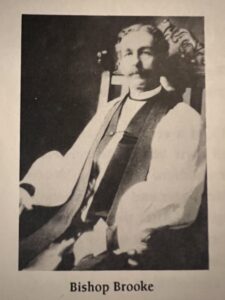
Bishop Brooke was described as a charismatic man in his early forties when took the post and was facing what seemed to be an impossible task for the time. Oklahoma and Indian Territory were known for unforgiving terrain and weather. With no public schools for his children, limited resources for his mission, and little support staff to accomplish his goals, Bishop Brooke certainly was facing a challenge. In the beginning, he regularly served dual roles as Bishop and Priest, responsible for baptizing, marrying, and burying members across Oklahoma and the Territory, which required long days of travel in often harsh conditions in order to perform them.
Bishop Brooke was undoubtedly surprised to find a packed Church, an impressive choir, and four baptismal candidates waiting for him when he arrived in Muskogee. He was evidently impressed because he immediately went to work organizing a Mission at Muskogee. A woman’s guild was also organized and a young Deacon, the Rev. Dwight Benton, Jr., arrived to take charge of the newly established Mission. The Bishop’s journal contains a brief entry commemorating our Beginning:
February 23 [1893]
Went to Muskogee.
Baptised 4 little children.
Read Evening Prayer.
Preached in the M.E. South.
Rev. Benton’s tenure at the Muskogee Mission would be short-lived, however. Young Mr. Benton only spent a few months in Muskogee before an unexpected departure. Bishop Brooke, while disappointed, would not be discouraged from developing the Muskogee Mission. It was not long before he organized a committee to handle the Mission’s affairs during the interim, as shown in the entry in the Bishop’s journal on May 11, 1894:
Appointed R. D. Martin (Warden), Andrew Jackson,
W. C. Jackson, Chas. H. Warth (Treas),
P. H. Ford, W. S. Boren,
H. J. Evans (Secy) as Executive Committee
Grace Mission, Muskogee.
The work and momentum continued. Another, later entry contained even more promising news:
Rev. Henry Tudor, late of Ferguson, Mo., has taken charge of our work in the neighborhood. His field includes Muskogee, Wagoner and Tahlequah, and so far as he may be able to reach them, some other points near there. he writes very encouragingly of the first month of his work and is hopeful good results. We believe his hopes will be realized. it is a good field and he is an earnest, energetic missionary.
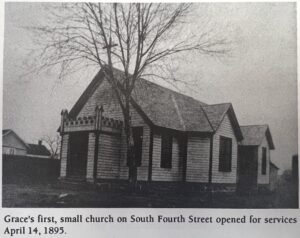 Rev. Tudor became the first Priest of Grace, having arrived May 1, 1894. It soon became evident that the Church would need a facility of its own to maintain its rapid growth. Parishioner Robert L. Owen, a member of the Cherokee Nation, who later would become Oklahoma’s first U.S. Senator, donated real estate for the construction of a sanctuary.
Rev. Tudor became the first Priest of Grace, having arrived May 1, 1894. It soon became evident that the Church would need a facility of its own to maintain its rapid growth. Parishioner Robert L. Owen, a member of the Cherokee Nation, who later would become Oklahoma’s first U.S. Senator, donated real estate for the construction of a sanctuary. The Church opened for services on Easter Sunday, April 14, 1895. Bishop Brooke had his first look at the structure June 16, 1895 and wrote in his journal:
In Grace Church with Rev. Mr. Tudor.
This is my first service in the new church, which has been in use since Easter; a very attractive and suitable building. Afternoon with Rev. Mr. Tudor.
I drove to Wagoner, sixteen miles in as hot a sun as I have ever had to ride through.
Because there was no rectory when Rev. Tudor arrived in Muskogee, he purchased several acres in the vicinity of what is now North 13th and 14th and Emporia and Martin Luther King Streets. The Tudors built a beautiful home and windmill with a large pond. Rev. Tudor kept horses and a fine carriage, with the royal coat-of-arms of the Tudors painted upon it. Locals referred to the Tudors’ home and land as “Tudorville” and it was a favorite destination for many Muskogeeans.
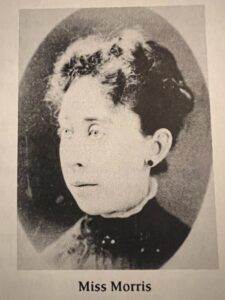
Unfortunately, a livery stable was constructed to the side of the Church facing the town in such a way that the building was entirely hidden from view. As Tag later told a friend, “Straight is the gate and narrow is the way which leads to my church.” The friend replied, “Yes, and few there be who find it.” Members of the Church raised the funds to purchase the lot across and further down Fourth street in order to relocate the building to a more appealing location. The Priest-in-Charge, Rev. Tudor, also resigned February 1, 1897, leaving the Church without leadership until the arrival of Rev. Arthur V. Francis on November 1st. In the interim, Mr. George Biller, lay reader and student at Berkley Divinity School, presided over services until Rev. Francis arrived.
Rev. Francis, ordained by Bishop Brooke as deacon and priest at St. Paul’s Cathedral in Oklahoma City, was described as “a superb preacher and musician and drew many people to the church.” Since Rev. Tudor had personally paid for the construction of “Tudorville,” the congregation immediately went to work planning for the development of a rectory by first establishing a building committee composed of Mr. George Williams, Mrs. Mary Pierson, and Mrs. M. R. Williams. The Ladies Guild also assisted in the fundraising. A six-room, one-story yellow frame rectory was completed in December of 1898. It faced Third Street just south of the old Presbyterian Church on the corner of Fourth Street and West Okmulgee.
Membership in the Episcopal Church in the territories under Bishop Brooke increased from 200 persons in 1893 to 1,323 in 1897. The Dawes Commission, the allotment of lands to tribal members, and a small oil boom resulted in significant population growth in Muskogee. Tams Bixby and Miss Susan Vaulx were among the Grace parishioners brought to town by work with the Commission. By 1901, the small church on Fourth Street did not have the capacity that was needed for a growing congregation. In response, the Ladies Guild once again went to work raising funds for the construction of a new church building. The City of Muskogee incorporated, street names (many of which still are the same today) were assigned, and the plat of the township was approved by the Department of Interior in the following years.
Rev. Francis resigned as rector on May 20, 1902 to accept a call to Minnesota. Parishioner Mr. David C. Lloyd served as the lay reader until the Rev. A. Basil Perry of West, Missouri, came to Grace on February 1, 1903. Months later on August 21, 1903, it was decided that the Church would purchase a building site at the northwest corner of Sixth Street and West Broadway. In a twelve month period between 1903 and 1904, Grace grew from 63 communicants to 141. The tremendous growth resulted in the congregation deciding that it was time for the “mission” to evolve. On February 1, 1904, Grace applied to Bishop Brooke for admittance as a parish. His resulting approval made Grace the first self-supporting parish in Indian Territory. The Articles of Association captured this moment appropriately:
We, whose names are herewith affixed, deeply impressed with the importance of the Christian religion and earnestly wishing to promote its holy influence in the hearts and lives of ourselves, our families and our neighbors, do hereby associate ourselves together, under the name and style and title of the Parish of Grace Church, City of Muskogee, Creek Nation, Ind. Ter; and by so doing do adopt the Constitution and Canons of the Protestant Episcopal Church in the United States of America and of this Diocese —
or Missionary Jurisdiction of Okla. and Ind. Ter.
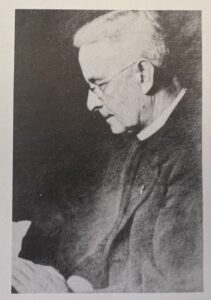
Rev. Hugh J. Llwyd was rector at Grace from 1906 to 1941
The document contained the signatures of thirty-seven members of Grace. On April 1, 1905, work on the foundation for a new building, capable of seating 200 persons, began. The cornerstone was laid seven weeks later on May 26, 1905, and the building was completed the following January. The Fourth Street building was sold and later moved to 610 Fondulac (now Martin Luther King) Street, where it served as a residence (and still does). Rev. Perry stayed through the completion of the new building and then resigned, answering a call to serve in San Angelo, Texas on January 31, 1906. Rev. Hugh J. Llwyd of Pawnee began his 35-year ministry at Grace’s new sanctuary and 231 communicants shortly thereafter on March 1, 1906.
A NEW ERA BEGINS
Rev. Llwyd was considered by many parishioners to be responsible for the growth and strength of Grace Church during his 35-year tenure. Of Welsh descent, he was approximately 5 feet, 10 inches tall, stockily built and notably strong. He previously had been a hockey player in Toronto and was an avid golfer. His deep, booming voice filled the Church every Sunday – Mrs. Llwyd joked that her husband “never could whisper.” Parishioner Alice Brown fondly recalled that “[e]verybody like him and he was the type that stayed put…[he] was very lovable and quite a man.”
His son Edwin, born in Muskogee in 1913, continued to be a faithful member of Grace well into his 80’s. His father, Hugh, was born March 31, 1870 in Manchester, England and was four years old when his parents moved him to Canada. Hugh’s father, Rev. Thomas Llwyd, became rector of All Saints Anglican Church and later also was archdeacon of the Diocese of Algoma. Hugh went into business in Toronto during his early years before moving to New York for work. Two brothers had already become Anglican priests when Hugh received his call and left New York to attend Kansas Theological Seminary in Wichita. After seminary, he came to Oklahoma and Indian Territory in 1899, where he was ordained by Bishop Brooke. He served in Stillwater and then Pawnee before marrying and moving to Muskogee in 1906. While in Pawnee, Rev. Llwyd would travel to Pawhuska to hold services whenever the month had five Sundays. In Pawhuska, he met a lady from Muskogee named Mary Morris Brenner (“Tag”), with whom he exchanged creative ideas on the construction of church facilities.
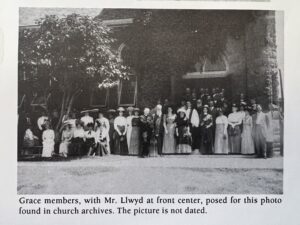
Muskogee, and in 1907, the newly admitted State of Oklahoma, were quickly growing. Bishop Brooke was appointed the Missionary Bishop of the newly formed State. In 1910, Rev. A. C. Roker organized a mission for Black residents of Muskogee. The congregation, named St. Philip’s, regularly met in the area of Grace Church until finding a new home in Muskogee in 1917. Unfortunately, much of the history of St. Philip’s was lost – however, it is known that the congregation moved to a building at 502 N. 9th Street in the 1930s. Grace and St. Philip’s worked together on a number of projects during their separate existences until the two were merged in the 1970s at the request of the Bishop.
During the rapid expansion of Muskogee and the State of Oklahoma, Bishop Brooke ultimately determined that he was unable to meet the demands of the entire state and, at the 1910 General Convention, a plan was approved to split the State into two districts. Bishop Brooke became the Missionary Bishop of the Western District, based in Oklahoma City, while the Rev. Theodore Payne Thurston became was consecrated the Bishop for the Eastern District on January 25, 1911. Shortly after his consecration, Bishop Thurston decided to move to Muskogee. During his tenure, Grace served as the Cathedral for Eastern Oklahoma. Tag fondly recalled of the new Bishop, “[He] soon won the affection of his own people and seemed to appeal very strongly to the members of the other Christian bodies, who were always glad to be present whenever the Bishop could visit us [in Pawhuska].”
Bishop Thurston’s broad appeal was readily evident when, in 1917, at the request of various pastors of Muskogee churches, he conducted a special farewell service for the young men preparing to leave for military duty during World War I. Bishop Thurston would remain in Muskogee until 1919 when news of Bishop Brooke’s death resulted in the two districts reuniting and Bishop Thurston relocating to Oklahoma City.
By 1917, Rev. Llwyd was presiding over a congregation that included 362 communicants. By 1920, that number had increased to 438. This increase in communicants occurred despite the growing influenza epidemic in 1918, which resulted in an order by the Muskogee Mayor for Grace and other churches to suspend services in an attempt to limit the spread of the virus. In the 1920s, Grace ranked as one of the “big three” churches in Oklahoma along with Tulsa Trinity and St. Paul’s in Oklahoma City. Each of the “big three” churches had over 500 individuals in their congregations.
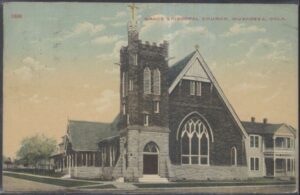
While the leadership and congregation of Grace welcomed the Church’s success, the existing building simply was not capable of supporting the growth. Two additional problems had added to the Church’s troubles: (1) an underground spring was discovered to be the culprit behind constant flooding of the Church basement; and, (2) Muskogee’s growing streetcar system had resulted in cars passing the Church at 15-minute intervals, bringing with them constant clanging and warning bells that even Rev. Llwyd’s booming voice could not overcome. On April 25, 1922, the Grace Vestry voted to move the church building to a lot up the street at the corner of 6th and Court, where it presently stands, as well as to make expansions to accommodate the growing congregation and ministries.
History of Our Church Leadership
1894-1897
Rev. Henry Tudor

1897-1902
Rev. Arthur Francis

1903-1906
Rev. A. Basil Perry

1906-1941
Rev. Hugh J. Llwyd

1941-1958
Rev. Paul Rudsil Palmer
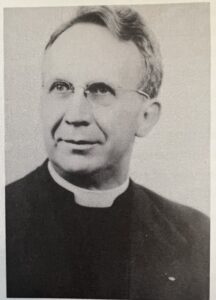
1958-1961
Rev. James Lawrence Basil Williams
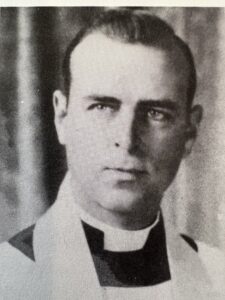
1961-1966
Rev. F. Grover Fulkerson
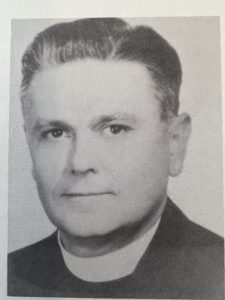
1966-1971
Rev. Daniel Leen
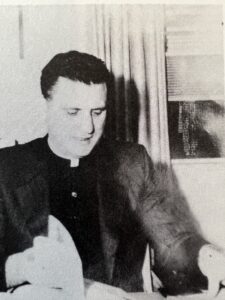
1971-1972
Rev. Sudduth R. Cummings
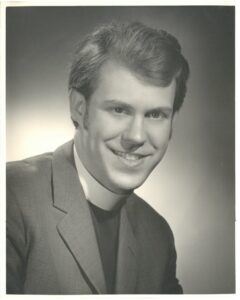
1972-1986
Rev. Edwin L. Hoover
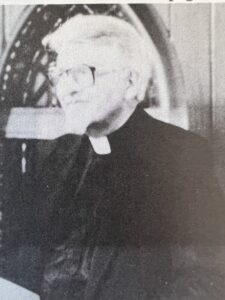
1986-1987
Rev. Richard C. Allen
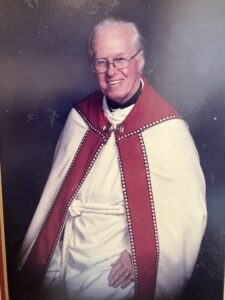
1987-1990
Rev. Drew H. Wales
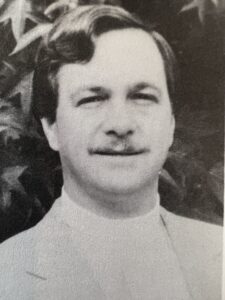
1990-2005
Rev. Max B. Berry
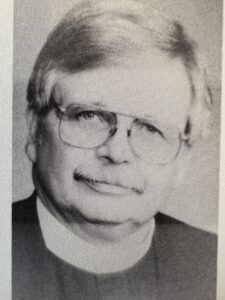
2005-2008
Rev. Kirk Woodliff
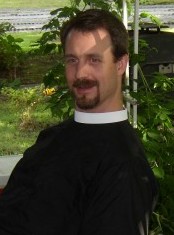
2008-2010
Pastor Jenny Pratt
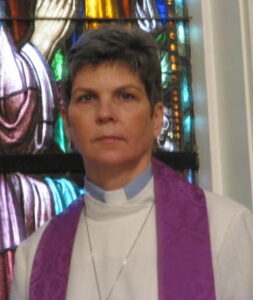
2010-2021
Rev. Bob Wickizer
